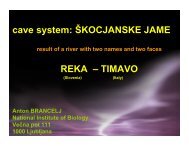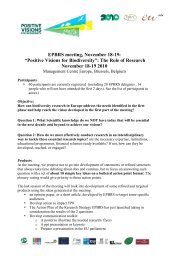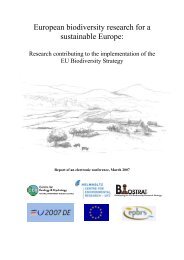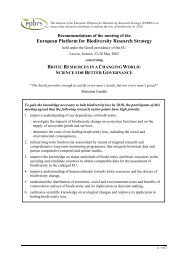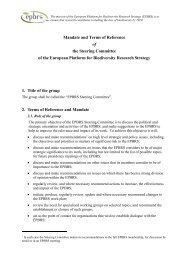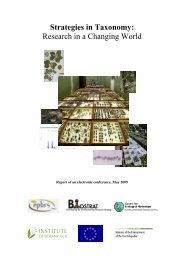Evaluation of the effectiveness of the New Instruments of ... - CORDIS
Evaluation of the effectiveness of the New Instruments of ... - CORDIS
Evaluation of the effectiveness of the New Instruments of ... - CORDIS
You also want an ePaper? Increase the reach of your titles
YUMPU automatically turns print PDFs into web optimized ePapers that Google loves.
Chart 3.9: Expectation for <strong>the</strong> future <strong>of</strong> <strong>the</strong> partnership – (n=275) - Results in % - Multiple<br />
answers possible<br />
Partnership will go on,<br />
independent <strong>of</strong> EU funding<br />
9<br />
7<br />
Partnership as is will seek<br />
additional funding<br />
10<br />
27<br />
Partnership will continue,<br />
might seek new funds<br />
Partnership likely to continue,<br />
but with differences<br />
9<br />
28<br />
38<br />
46<br />
Unsuccessful<br />
Successful<br />
Partnership created for<br />
project, not sure will continue<br />
15<br />
29<br />
O<strong>the</strong>r<br />
7<br />
5<br />
0 10 20 30 40 50<br />
Successful and unsuccessful proposers have answered this question from different<br />
perspectives and <strong>the</strong>refore results need to be interpreted differently.<br />
For unsuccessful proposers, <strong>the</strong> proportion <strong>of</strong> partnerships that are likely to continue even if<br />
under different forms is high. Results show that 57% <strong>of</strong> consortia created in <strong>the</strong> context <strong>of</strong><br />
unsuccessful proposals would continue in one form or ano<strong>the</strong>r. This is a high additionality<br />
effect <strong>of</strong> <strong>the</strong> application process.<br />
For <strong>the</strong> successful proposers, <strong>the</strong> interesting result is that a large group plans to seek<br />
additional funds ei<strong>the</strong>r during or after <strong>the</strong> project (both more than 25 %).<br />
Results on this question also confirm <strong>the</strong> ‘inflation’ in <strong>the</strong> consortia for new instruments.<br />
16 % <strong>of</strong> successful proposers do not expect this consortium to continue after <strong>the</strong> project is<br />
finished and 42 % expect it will continue but at this early stage <strong>the</strong>y already expect it will be<br />
under a different form. These two percentages are high.<br />
Continuation <strong>of</strong> <strong>the</strong> partnership under its present form seems to be higher with NoE, probably<br />
due to <strong>the</strong> “durable integration” requirement, than with IP projects:<br />
• 36 % <strong>of</strong> NoE coordinators expect <strong>the</strong>y will seek additional funding during <strong>the</strong> project,<br />
against 23 % <strong>of</strong> IP coordinators<br />
• 42 % <strong>of</strong> NoE coordinators expect <strong>the</strong>y will continue with <strong>the</strong>ir network after its end<br />
(after <strong>the</strong> end <strong>of</strong> <strong>the</strong> funding period) and <strong>the</strong>y will seek additional funding for this,<br />
against 25 % <strong>of</strong> IP coordinators.<br />
• Only 1 <strong>of</strong> 36 NoE coordinator said not to be sure <strong>the</strong> network would continue, against<br />
16 % <strong>of</strong> <strong>the</strong> IP coordinators.<br />
63



